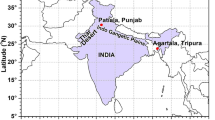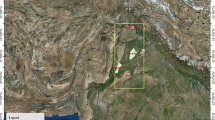Abstract
One of the significant mountain region running parallel to India's west coast is the Western Ghats. Normally, this area receives three times rainfall because it is nearly vertical to the low-level jet stream. But this rainfall is affected in recent years due to the aerosol particles. Aerosols, tiny particles present in the atmosphere, play crucial roles in weather and climate. It is generated primarily as solid particles, for example, Asian dust, Saharan dust, sea salt, or soot. Aerosols can have a variety of impacts (e.g., direct and indirect effects) on the atmosphere, which can lead to the earth's radiation budget. It has a strong impact on the formation of clouds and precipitation processes also. The aerosol change-based influences are considered as the main factor related to air pollution controlling and environmental regulations. Hence, this article mainly concentrates on climate influences related to global aerosol variation. In this paper, recent aerosol behaviors and their impacts on the Western coastal (WG) region of India from 2014 to 2017 are analyzed. From the analysis, we observed that the precipitation is increased in the West Coast region.










Similar content being viewed by others
References
Aryasree S, Nair PR, Hegde P (2020) Radiative characteristics of near-surface aerosols at a tropical site: an estimation based on concurrent measurements of their physico-chemical characteristics. J Earth Syst Sci 129(1):1–25
Bell TL, Rosenfeld D, Kim KM, Yoo JM, Lee MI, Hahnenberger M (2008) Midweek increase in US summer rain and storm heights suggests air pollution invigorates rainstorms. J Geophys Res Atmos 113(D02209):1–22
Bellouin N, Quaas J, Gryspeerdt E, Kinne S, Stier P, Watson-Parris D, Stevens B (2020) Bounding global aerosol radiative forcing of climate change. Rev Geophys 58(1):e2019RG000660
Chakraborty S, Fu R, Rosenfeld D, Massie ST (2018) The influence of aerosols and meteorological conditions on the total rain volume of the mesoscale convective systems over tropical continents. Geophys Res Lett 45:13099–13106
Chen T, Li Z, Kahn RA, Zhao C, Rosenfeld D, Guo J, Chen D (2021) Potential impact of aerosols on convective clouds revealed by Himawari-8 observations over different terrain types in eastern China. Atmos Chem Phys 21(8):6199–6220
Choudhury G, Tyagi B, Vissa NK, Singh J, Sarangi C, Tripathi SN, Tesche M (2020) Aerosol-enhanced high precipitation events near the Himalayan foothills. Atmos Chem Phys 20(23):15389–15399
Choudhury BA, Goswami BN, Zahan Y, Rajesh PV (2021) Seasonality in power law scaling of convective and stratiform rainfall with lightning intensity over Indian Monsoon regions. Atmos Res 248:105265
Das SK, Konwar M, Chakravarty K, Deshpande SM (2017) Raindrop size distribution of different cloud types over the Western Ghats using simultaneous measurements from micro-rain radar and disdrometer. Atmos Res 186:72–82
Gautam R, Singh MK (2018) Urban Heat Island over Delhi punches holes in widespread fog in the Indo-Gangetic Plains. Geophys Res Lett 45:1114–1121
Gautam R, Hsu NC, Lau KM (2010) Premonsoon aerosol characterization and radiative effects over the Indo-Gangetic Plains: implications for regional climate warming. J Geophys Res Atmos 115:D17208
Goswami BN, Kripalani RH, Borgaonkar HP, Preethi B (2016) Multi-decadal variability in Indian summer monsoon rainfall using proxy data. In: Climate change: multidecadal and beyond, pp 327–345
Grossman RL, Durran DR (1984) Interaction of low-level flow with the Western Ghats Mountains and offshore convection in the summer monsoon. Mon Weather Rev 112:652–672
Gunnell Y (1997) Relief and climate in South Asia: the influence of the Western Ghats on the current climate pattern of peninsular India. Int J Climatol 17:1169–1182
Gunnell Y, Bourgeon G (1997) Soils and climatic geomorphology on the Karnataka Plateau, peninsular India. CATENA 29:239–262
Guo J, Deng M, Fan J, Li Z, Chen Q, Zhai P, Dai Z, Li X (2014) Precipitation and air pollution at mountain and plain stations in northern China: insights gained from observations and modeling. J Geophys Res Atmos 119:4793–4807
Guo J, Deng M, Lee SS, Wang F, Li Z, Zhai P, Liu H, Lv W, Yao W, Li X (2016) Delaying precipitation and lightning by air pollution over the Pearl River delta. Part I: observational analyses. J Geophys Res Atmos 121:6472–6488
Guo J, Su T, Li Z, Miao Y, Li J, Liu H, Xu H, Cribb M, Zhai P (2017) Declining frequency of summertime local-scale precipitation over eastern China from 1970 to 2010 and its potential link to aerosols. Geophys Res Lett 44:5700–5708
Guo J, Su T, Chen D, Wang J, Li Z (2019) Declining summertime local-scale precipitation frequency over China and the United States, 1981–2012: the disparate roles of aerosols. Geophys Res Lett 46(22):13281–13289
Harikishan G, Padmakumari B, Maheskumar RS, Kulkarni JR (2015) Radiative effect of dust aerosols on cloud microphysics and meso-scale dynamics during monsoon breaks over Arabian Sea. Atmos Environ 105:22–31
Hegde P, Vyas BM, Aswini AR, Aryasree S, Nair PR (2020) Carbonaceous and water-soluble inorganic aerosols over a semi-arid location in north west India: seasonal variations and source characteristics. J Arid Environ 172:104018
Hodzic A, Duvel JP (2018) Impact of biomass burning aerosols on the diurnal cycle of convective clouds and precipitation over a tropical island. J Geophys Res Atmos 123(2):1017–1036
Hoskins BJ, Karoly DJ (1981) The steady linear response of a spherical atmosphere to thermal and orographic forcing. J Atmos Sci 38(6):1179–1196
Indu J, Kumar DN (2015) Evaluation of precipitation retrievals from orbital data products of TRMM over a Subtropical Basin in India. IEEE Trans Geosci Remote Sens 53:6429–6442
Joseph PV, Simon A (2005) Weakening trend of the southwest monsoon current through peninsular India from 1950 to the present. Curr Sci 89:687–694
Kant S, Panda J, Rao P, Sarangi C, Ghude SD (2021) Study of aerosol-cloud-precipitation-meteorology interaction during a distinct weather event over the Indian region using WRF-Chem. Atmos Res 247:105144
Kedia S, Ramachandran S, Holben BN, Tripathi SN (2014) Quantification of aerosol type, and sources of aerosols over the Indo-Gangetic Plain. Atmos Environ 98:607–619
Khain A, Rosenfeld D, Pokrovsky A (2005) Aerosol impact on the dynamics and microphysics of deep convective clouds. Q J R Meteorol Soc 131:2639–2663
Konwar M, Das SK, Deshpande SM, Chakravarty K, Goswami BN (2014) Microphysics of clouds and rain over the Western Ghat. J Geophys Res Atmos 119:6140–6159
Koren I, Feingold G, Remer LA (2010) The invigoration of deep convective clouds over the Atlantic: aerosol effect, meteorology or retrieval artifact? Atmos Chem Phys 10:8855–8872
Krishnamurthy V, Shukla J (2000) Intraseasonal and interannual variability of rainfall over India. J Clim 13(24):4366–4377
Kulkarni P, Sreekanth V (2020) Spaceborne lidar retrieved composite and speciated aerosol extinction profiles and optical depths over India: a decade of observations. Atmos Pollut Res 11(5):946–962
Kumar S (2015) A 10-year climatology of vertical properties of most active convective clouds over the Indian regions using TRMM PR. Theor Appl Climatol 127:429–440
Kumar S, Hazra A, Goswami BN (2014) Role of interaction between dynamics, thermodynamics and cloud microphysics on summer monsoon precipitating clouds over the Myanmar coast and the Western Ghats. Clim Dyn 43:911–924
Lal DM, Pawar SD (2009) Relationship between rainfall and lightning over central Indian region in monsoon and premonsoon seasons. Atmos Res 92:402–410
Lau WK, Kim KM, Shi JJ, Matsui T, Chin M, Tan Q, Tao WK (2017) Impacts of aerosol–monsoon interaction on rainfall and circulation over Northern India and the Himalaya Foothills. Clim Dyn 49(5):1945–1960
Li Y, Day DA, Stark H, Jimenez JL, Shiraiwa M (2020) Predictions of the glass transition temperature and viscosity of organic aerosols from volatility distributions. Atmos Chem Phys 20(13):8103–8122
Lin JC, Matsui T, Pielke SA, Kummerow C (2006) Effects of biomass-burning-derived aerosols on precipitations and clouds in the Amazon Basin: a satellite-based empirical study. J Geophys Res Atmos 111:1–14
Liu C, Zipser EJ (2015) The global distribution of largest, deepest, and most intense precipitation systems. Geophys Res Lett 42:3591–3595
Maheskumar RS, Padmakumari B, Konwar M, Morwal SB, Deshpande CG (2018) Characterization of hydrometeors and precipitation over the Indian monsoon region using aircraft measurements. Atmos Res 205:147–154
Manoj MG, Devara PCS, Safai PD, Goswami BN (2011) Absorbing aerosols facilitate transition of Indian monsoon breaks to active spells. Clim Dyn 37:2181–2198
Medina S, Houze RA Jr, Kumar A, Niyogi D (2010) Summer monsoon convection in the Himalayan region: terrain and land cover effects. Q J R Meteorol Soc 136(648):593–616
Mehta M (2015) A study of aerosol optical depth variations over the Indian region using thirteen years (2001–2013) of MODIS and MISR level 3 data. Atmos Environ 109:161–170
Mishra MK, Rajeev K, Thampi BV, Parameswaran K, Nair AKM (2010) Micro pulse lidar observations of mineral dust layer in the lower troposphere over the southwest coast of peninsular India during the Asian summer monsoon season. J Atmos Solar-Terr Phys 72:1251–1259
Mukherjee S, Singla V, Meena GS, Aslam MY, Safai PD, Buchunde P, Pandithurai G (2020) Sub micron aerosol variability and its ageing process at a high altitude site in India: impact of meteorological conditions. Environ Pollut 265:115019
Nair A, Indu J (2017) Performance assessment of multi-source weighted-ensemble precipitation (MSWEP) product over India. Climate 5:2
Niu F, Li Z (2012) Systematic variations of cloud top temperature and precipitation rate with aerosols over the global tropics. Atmos Chem Phys 12:8491–8498
Nizar S, Dodamani BM (2019) Spatiotemporal distribution of aerosols over the Indian subcontinent and its dependence on prevailing meteorological conditions. Air Qual Atmos Health 12(4):503–517
Persad GG, Caldeira K (2018) Divergent global-scale temperature effects from identical aerosols emitted in different regions. Nat Commun 9(1):1–9
Priti H, Aravind NA, Shaanker RU, Ravikanth G (2016) Modeling impacts of future climate on the distribution of Myristicaceae species in the Western Ghats, India. Ecol Eng 89:14–23
Raha A, Hussain SA (2016) Factors affecting habitat selection by three sympatric otter species in the southern Western Ghats, India. Acta Ecol Sin 36:45–49
Ramachandran S, Kedia S (2013) Aerosol-precipitation interactions over India: review and future perspectives. Adv Meteorol 2013:1–20
Sandeep S, Ajayamohan RS (2015) Poleward shift in Indian summer monsoon low level jetstream under global warming. Clim Dyn 45:337–351
Satheesh SK, Moorthy KK, Das I (2001) Aerosol spectral optical depths over the bay of Bengal, Arabian Sea and Indian Ocean. Curr Sci 81:1617–1625
Singh RP, Dey S, Tripathi SN, Tare V, Holben B (2004) Variability of aerosol parameters over Kanpur, northern India. J Geophys Res Atmos 109:1–14
Singh GK, Choudhary V, Rajeev P, Paul D, Gupta T (2020) Understanding the origin of carbonaceous aerosols during periods of extensive biomass burning in northern India. Environ Pollut 270:116082
Tao W-K, Chen J-P, Li Z, Wang C, Zhang C (2012) Impact of aerosols on convective clouds and precipitation. Rev Geophys 50:1–62
Trenberth KE (2020) Understanding climate change through Earth’s energy flows. J R Soc NZ 50(2):331–347
Tripathi SN, Dey S, Chandel A, Srivastava S, Singh RP, Holben BN (2005) Comparison of MODIS and AERONET derived aerosol optical depth over the Ganga Basin, India. Ann Geophys 23:1093–1101
Westervelt DM, Mascioli NR, Fiore AM, Conley AJ, Lamarque JF, Shindell DT, Horowitz LW (2020) Local and remote mean and extreme temperature response to regional aerosol emissions reductions. Atmos Chem Phys 20(5):3009–3027
Xu W, Zipser EJ (2012) Properties of deep convection in tropical continental, monsoon, and oceanic rainfall regimes. Geophys Res Lett 39:1–6
Zipser EJ, Lutz KR (1994) The vertical profile of radar reflectivity of convective cells: a strong indicator of storm intensity and lightning probability? Mon Weather Rev 122(8):1751–1759
Author information
Authors and Affiliations
Corresponding author
Ethics declarations
Conflict of interest
All authors declare that they have no conflicts of interest.
Rights and permissions
About this article
Cite this article
Kumar, K.P., Manjunatha, B.R. Impact of Aerosols on Precipitation over Western Ghats. Aerosol Sci Eng 5, 393–403 (2021). https://doi.org/10.1007/s41810-021-00111-8
Received:
Revised:
Accepted:
Published:
Issue Date:
DOI: https://doi.org/10.1007/s41810-021-00111-8




